
Hall of Fame: Members

Hall of Fame: Members
CTA Hall of Fame
The CTA Hall of Fame honours Canadians who have made a positive impact on trapshooting in Canada and includes a category for the top Shooters and influential Contributors and Builders of our sport.
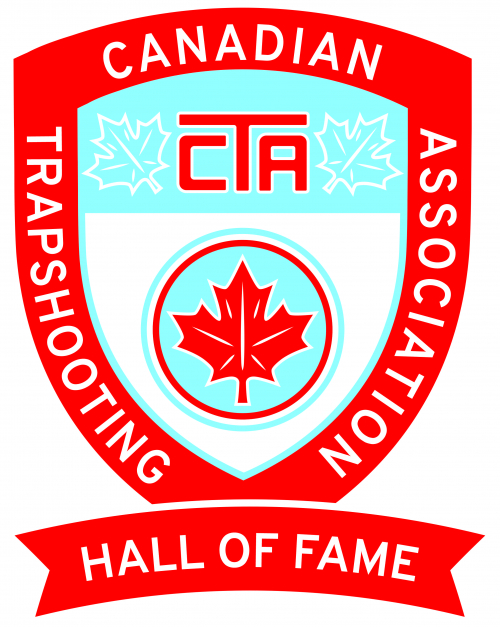
If you would like to nominate an individual for the CTA Hall of Fame, complete the CTA Hall of Fame form and submit to the CTA Hall of Fame Committee by the November 1 deadline.
Inductees for 2025
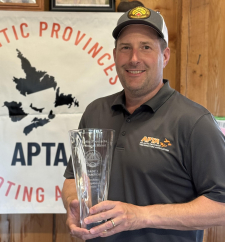
Andrea Bassan
Type: Contributor
Category:
Province: Atlantic Provinces
Since 1998, Andrea has dedicated his time to such positions as St. John’s Rod and Gun Club President and Trap Chairman, Atlantic Provinces Trapshooting Association President, CTA President, and Atlantic Provinces Delegate for the ATA and CTA.
Stay tuned for Andrea's complete biography.

Peter Tsementzis
Type: Shooter
Category:
Province: Ontario
Peter was first introduced to trapshooting in 1984, when he went to Hamilton Gun Club (his current home club) with his father, Chris Tsementzis Sr., to watch the Provincials.
Stay tuned for Peter's complete biography.
Inductees for 2022

Don Blow
Type: Contributor
Category:
Province:

James Boa
Type: Contributor
Category:
Province:
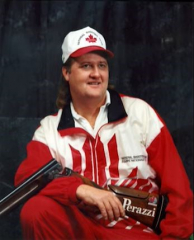
Rod Boll
Type: Shooter
Category:
Province: Saskatchewan
Rod finished 19th in the double trap event with a total of 130 points. Rod also represented Canada at the Pan American Games in 1995 and 2003, and won over 20 provincial and national titles in total.
Rod continued to reside near his hometown throughout his life where he owned a grain farm, was active within local recreational hockey teams, and served on the RM of Fillmore council. He was active in trapshooting up until his death from a heart attack in 2021, having most recently won the Canadian Handicap title in 2019. Both of his sons, Schön and Kahl, were also active in trapshooting.
In 2022, Rod was inducted into the Saskatchewan Sports Hall of Fame.
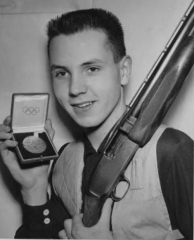
George Genereux
Type: Shooter
Category:
Province:
George was named Saskatoon's Citizen of the Year for 1952, and won the Lou Marsh Memorial Trophy as Canada's outstanding athlete.
Just a few years later his sporting career was over. Even before winning his Olympic Gold Medal, he had been diagnosed with rheumatoid arthritis, which he had suffered from and fought his whole life.
George Genereux received his Bachelor of Arts degree from the University of Saskatchewan and then studied medicine at McGill University.
He received his Fellowship in Radiology from the Royal College of Physicians and Surgeons in 1968. Dr Genereux held the position of Professor of Radiology at Royal University Hospital, and published many papers and collaborated on radiology textbooks.
"At the time of his death he was working with three other internationally known specialists on the third and fourth volumes of a study of chest diseases." The same article continued on to say, "Despite his own bad health, Genereux worked to advance the cause of medical knowledge. ‘If you can't help yourself, you should use your God-given talents to help others,’ he said in one interview."
Dr. George Genereux died on April 10, 1989. He is buried in Woodlawn Cemetery with his father, Dr. Arthur Genereux, and his mother, Catherine.

Harold Herron
Type: Contributor
Category:
Province:

Vera Holsworth
Type: Shooter
Category:
Province:
One year at the Canadian Trapshooting Championships in Edmonton, judge Neil Primrose, himself a prominent shooter commented that Vera Holdsworth has won the championship trophy so many times that if she wins it again, we will see that is retired to her.
She won and still has the gorgeous trophy surrounded by numerous others proudly displayed in her trophy room.
An Albertan champion 19 times, (the last time in 1976), Canadian Ladies champion 13 times (last time in 1969), North American Ladies champion in 1959, and the first woman to be on both the Canadian and American Trapshooting teams as well as the All-Canadian and All- American teams are just a few examples of an unparalleled record of this outstanding athlete.
Competing at a time when there was less competition for women, Vera was invited on many occasions to compete with the men. In 1961, the Canadian Men’s Team requested the Canadian Trapshooting Association to allow Vera to compete as the 5th team member. At this meet, the team set a new Canadian record when they shot 498 out of 500 with Vera contributing her share with 99 out of 100.
Awards to Vera have been numerous. In 1954 Vera she was made a life member of the ATA. On the 50th anniversary of the province, she was recognized for distinguished and exceptional public service. In 1972, the province again acknowledged with an acheivement award. During the same year, the Alberta Trapshooting Association, made her a life member.
Inducted into the Alberta Trapshooting Hall of Fame, named All-American five (5) times, Captain of the All-Canada Trap Team, and voted to the Sports Field Magazine Award. All-American Trapshooting Team (one of the most difficult to win) are a few more accolades that she has received.
Throughout her career, she has encouraged and assisted young people to take up the sport. Always enthusiastic she is a wonderful ambassador for Alberta and Canada and the sport of trapshooting.

Harold Lister
Type: Contributor
Category:
Province:

Floyd Nattrass
Type: Contributor
Category:
Province:
Floyd Nattrass, trapshooter and salesman (1918-2004)
After competing at the Olympics without a coach, he learned a bitter lesson and became a gifted teacher of marksmanship.
By Tom Hawthorn
Special to the Globe and Mail,
Updated Monday January 3rd, 2005
A keen eye for sniping game birds on the family ranch in Alberta led Floyd Nattrass all the way to an Olympic shooting range. A spectacular collapse in the final rounds at the Tokyo Games in 1964, and his own disappointment with his performance, later made him a shooting coach of uncommon insight.
Mr. Nattrass taught several generations of Alberta trap shooters, including up-and-comer Ty Bietz, who is regarded as a future Olympian. The student to have enjoyed the greatest success, however, has been his daughter, Susan Nattrass, who in 1976 became the first woman to compete in trapshooting at the Olympics.
Mr. Nattrass preached a commitment to the basics of the sport, such as how to wield a shotgun. "Bring it up to your face, not the shoulder," he once instructed a reporter from the Calgary Herald. "Don't muscle the gun. The left hand is like holding a fresh egg. The right hand is like holding a rattlesnake by the neck, so it doesn't bite you."
Born and raised in rural Alberta, Floyd Caldwell Nattrass spent his early years on a ranch on which his father operated livery stables. As a boy, Floyd's daily duty was to shoot duck, pheasant or partridge for the family supper table. He also earned spending money by plugging such prairie nuisances as gophers and weasels at 50 cents each.
He hunted elk and other larger game as a young adult, although his reputation was as a scourge of coyotes, whose pelts he sold to build a nest egg for married life.
After joining the RCMP, Mr. Nattrass was posted to New Brunswick as a constable. A Golden Gloves champion in his youth, he taught boxing to fellow Mounties until a bad back led to an early retirement.
Mr. Nattrass became a fruit salesman who moonlighted as a hunting guide. On one such expedition, he struck up a friendship with the president of an Edmonton clothing manufacturer, who hired the guide as a travelling salesman. For many years, Mr. Nattrass sold the blue jeans and other durable work clothes made by GWG, the Great Western Garment Co., and became national sales manager.
It was during another hunting foray that a client suggested the dead-eye shot take up competitive shooting and Mr. Nattrass soon won provincial and national titles. He represented Canada at the world championships three times.
In 1958, Mr. Nattrass won the Sahara Gun Club's annual midwinter trap shoot in Las Vegas by hitting 98 of 100 targets before striking all 25 clay pigeons in a shoot-off against a Kansan and a Californian.
The 1964 Olympic trapshooting competition was held in the Tokyo suburb of
Tokorozawa, where Mr. Nattrass competed without a coach. After six of eight rounds, the Alberta shooter was tied for fourth place, trailing the leader by just three points and in contention for a medal. Then calamity struck. His timing slowed even as he perceived his trigger finger to be too eager and he finished ninth.
Later, the silver medalist from the Soviet Union and a sheik from the United Arab Republic told Mr. Nattrass they had spotted the flaw in his technique, though they felt it improper to tell him during competition. The disappointed shooter made a lifetime commitment to provide coaching -- the lack of which he felt had cost him a medal.
While he grounded his daughter in the fundamentals of the sport, she found her father's intense presence at competitions to be a distraction. He was asked to stay away and, since 1969, her mother has been her coach. Her parents have long been separated.
At the 1976 Olympics in Montreal, Ms. Nattrass became the first woman to compete against men at trapshooting. Her lobbying eventually led to women gaining their own shooting events.
Mr. Nattrass continued to give shooting lessons until slowed by ill health earlier this year. He also tinkered with equipment to improve the sport, especially sights. According to the Herald, he owned a patent for a device he called the Super Sighter.
Floyd Nattrass was born in Manyberries, Alta., on Jan. 2, 1918. He died at High River Hospital on Dec. 7, 2004. He was 86. He leaves daughter, Susan Nattrass, a medical researcher in Seattle; sons Brian Nattrass, a lawyer and author from Gibsons, B.C.; and Dr. Gary Nattrass, an orthopedic surgeon in Australia; their mother, Marie; and three grandchildren.

Thomas Oliver Jr
Type: Contributor
Category:
Province:
Tom served one year as the Ontario Provincial Trapshooting Association President in 1952.
Tom was also a founding director of the Canadian Trapshooting Association (1956) and served as its president from 1956-1960.
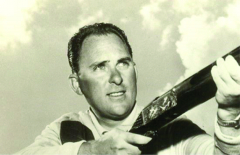
Frank Opsal
Type: Shooter
Category:
Province:
When Frank Opsal was young, an uncle took him to the marshes of Lulu Island and taught him how to shoot. By the time he retired some four decades later, Opsal had won over 300 tournaments. He was one of the first Canadians to shoot trap and skeet internationally and his accomplishments paved the way for other competitors.
Opsal was named to “Sports Afield” Canadian all–star team in 1952-54 and 1957, and the American all–star team in 1962. He was a six–time BC skeet champion taking the crown in 1954-55, 1959, 1961-62, and 1967. He was BC trap shooting champion ten times between 1954–72 in singles, high overall, or handicap events. He shot a perfect score (200 x 200) in 1972.
Opsal was on the Pacific International Trap–Shooting Association all–star team seven times between 1955–71. He captained the BC all–star trap and skeet shooting combined team in 1955–56 and 1960–63. Opsal was also a three–time Canadian trapshooting champion winning the singles in 1956 and high overall in 1959 and 1966. He was rated as one of top three shooters fifteen times between 1956–71.
Opsal was a member of the Canadian trap shooting team at the 1956 Olympic Games in Melbourne, Australia. Following the Olympics, Opsal’s strong results continued. He was the singles winner at the 1957 Western zone championships. He was a member of the “Hunting and Fishing in Canada” all–star team from 1960-64. In 1961, he was the BC Amateur Trapshooting Association singles and high all–round champion. There, he registered the first perfect score in BC history.
Opsal captained the Canadian team at the 1962 world trap shooting championships in Cairo, Egypt. He was named to the “Rod & Gun in Canada” all–star team in 1966.

Neil Primrose
Type: Contributor
Category:
Province:
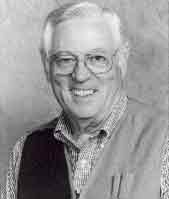
Harry Willsie
Type: Shooter
Category:
Province: Quebec
A life member of the ATA since the late '50s, Harry sponsored the High Canadian trophies at the Grand for decades. He helped introduce plastic cards for entry into tourna¬ments, and a "Continental" style of simulated Olympic trap to the Grand. He also assisted in bringing the Atlantic Provinces into the ATA and the Canadian Trapshooting Association into the Shooting Federation of Canada. An organizer and director of GA and International shoots, Harry introduced dozens of people to the sport, helping to finance both individuals and teams. He was a reg¬ular on radio and TV during the 1960s and '70s, promoting trap¬shooting in Quebec, and he aided Perazzi, Valmet and SKB in gun design and development.
Representing Quebec as the ATA Delegate from 1959-'71, Harry also served as the director of the Canadian Olympic Association, president of the Canadian Trapshooting Association from 1963 to '67, and director of the Provincial Trapshooting Association.
The winner of seven Grand American trophies, Harry collected 26 Quebec provincial championships during his career-five singles, seven doubles, six all-around, five veteran and three senior vet. In Eastern Zone competition, he earned the 1961 doubles crown and the handicap and all-around titles two years later. He was a mem¬ber of the 1964 All-American men's second team and an 18-time member of Quebec's All-Star team.
He represented Canada in trap in the 1964 Olympics and was part of the '68 and '76 skeet teams. He was the coach and manager of the shotgun team in 1980 at an alternate tournament, which was held because of the boycott of the Games in Moscow. The first Canadian to break 100 in doubles, Harry was the 16th in the ATA to accomplish the feat. He was also part of the squad that set the for¬mer doubles record of 490x500, which the group accomplished at the 1963 Eastern Zone Shoot. Harry and Frank Little each carded perfect centuries that day, and the event marked the first time two 100s were registered in twins in the same tournament and on the same squad.
Born in Missouri, Harry moved to Canada in 1953 to work the beginning of privately owned television. During his life, he also worked in public relations, publishing and as a sporting goods wholesaler.
"Harry was proud of everything he won," his wife Cleusa said. "Everything meant so much to him." He traveled to the Arctic on scientific expeditions and took a clay target with him on one of these trips. When he arrived, he shot at the target and declared himself the Arctic's clay target champion.

Harry Willsie
Type: Contributor
Category:
Province: Quebec
A life member of the ATA since the late '50s, Harry sponsored the High Canadian trophies at the Grand for decades. He helped introduce plastic cards for entry into tourna¬ments, and a "Continental" style of simulated Olympic trap to the Grand. He also assisted in bringing the Atlantic Provinces into the ATA and the Canadian Trapshooting Association into the Shooting Federation of Canada. An organizer and director of GA and International shoots, Harry introduced dozens of people to the sport, helping to finance both individuals and teams. He was a reg¬ular on radio and TV during the 1960s and '70s, promoting trap¬shooting in Quebec, and he aided Perazzi, Valmet and SKB in gun design and development.
Representing Quebec as the ATA Delegate from 1959-'71, Harry also served as the director of the Canadian Olympic Association, president of the Canadian Trapshooting Association from 1963 to '67, and director of the Provincial Trapshooting Association.
The winner of seven Grand American trophies, Harry collected 26 Quebec provincial championships during his career-five singles, seven doubles, six all-around, five veteran and three senior vet. In Eastern Zone competition, he earned the 1961 doubles crown and the handicap and all-around titles two years later. He was a mem¬ber of the 1964 All-American men's second team and an 18-time member of Quebec's All-Star team.
He represented Canada in trap in the 1964 Olympics and was part of the '68 and '76 skeet teams. He was the coach and manager of the shotgun team in 1980 at an alternate tournament, which was held because of the boycott of the Games in Moscow. The first Canadian to break 100 in doubles, Harry was the 16th in the ATA to accomplish the feat. He was also part of the squad that set the for¬mer doubles record of 490x500, which the group accomplished at the 1963 Eastern Zone Shoot. Harry and Frank Little each carded perfect centuries that day, and the event marked the first time two 100s were registered in twins in the same tournament and on the same squad.
Born in Missouri, Harry moved to Canada in 1953 to work the beginning of privately owned television. During his life, he also worked in public relations, publishing and as a sporting goods wholesaler.
"Harry was proud of everything he won," his wife Cleusa said. "Everything meant so much to him." He traveled to the Arctic on scientific expeditions and took a clay target with him on one of these trips. When he arrived, he shot at the target and declared himself the Arctic's clay target champion.
Inductees for 2024
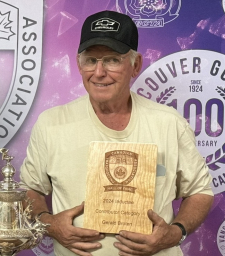
Gerald Broten
Type: Contributor
Category: Sr Veteran
Province: British Columbia
Jerry has been a dedicated ATA delegate and Vice-President of the BCTA, holding life memberships in both the ATA and PITA organizations. He has traveled extensively across Canada and the USA, often with his family, to participate in shooting events. Known for his hands-on approach, Jerry was frequently found fixing trap machines or performing gunsmithing on the tailgate of his truck, sometimes needing to be pulled away from helping others just to take his own turn at shooting.
He competed at more than 44 different clubs across North America, from Alaska to Hawaii and took on significant tasks at clubs beyond his own, helping to improve facilities and equipment to accommodate more shooters. Jerry was always ready to diagnose and repair trap machines or assist in any capacity needed to ensure the success of shooting events.
Jerry's contributions extended beyond his technical skills. He started G&R Sales, specializing in Kreighoff shotguns, gunsmithing and ammunition sales, often providing repairs at little to no cost. His generosity also led him to provide essential resources like targets and trap machines to support smaller clubs facing financial difficulties.
Together with his wife, Rene, Jerry raised four children while managing his businesses and volunteering thousands of hours at various clubs. His shooting accomplishments are impressive, with 444,100 PITA targets and 184,900 ATA targets, with a combined total of 629,000 targets.
Jerrys commitment to the sport went beyond the shooting range. He is known for his karaoke performances, spreading joy and camaraderie among fellow shooters long after the competitions ended. His passion and enthusiasm for the sport and its community have left a lasting impact, making him a deserving inductee into the CTA Hall of Fame. His contributions to trapshooting are and have been appreciated by all.
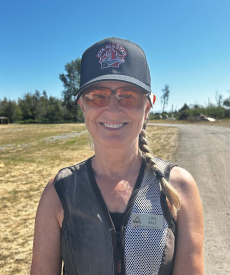
Lisa Salt
Type: Shooter
Category: Lady II
Province: British Columbia
While living in Vancouver and attending the University of British Columbia, Lisa spent 3 years of her trapshooting career concentrating on International Trapshooting. In 1985 she proudly won a bronze medal, along with her 2 female teammates, at the World Trapshooting Championships in Montecatini, Italy. Shortly thereafter she gave up the supposed fame and glory of international trap for the more social and friendly sport of American trapshooting.
Lisa has since won the Provincial Handicap (1997), the BC Ladies Provincial Singles title a total of 17 times, as well as the High All Around 24 times the Ladies Handicap 4 times and the Ladies Doubles 24 times. She has also won titles at the PITA Grand Pacific Championships, 3 doubles titles, 1 singles and the Ladies HOA and HAA 1 time.
She has 9 - 100 straights in singles to her name thus far. Lisa hit the 27 yard line in 2002 and has received many honorary punches from that spot. Lisa has made the BC Provincial All Stars 23 times, 21 as High Lady and twice on the Provincial First Team.
Lisa has recorded 26 years on the PITA All Star Team, achieving the top spot in first position on the Ladies 1st Team in 1993, 1994, 2004, 2008, 2009, 2010, 2011, 2012 and 2016. Lisa is the first Canadian Lady shooter to make the CTA All Stars at its inception in 2021 and she has repeated that achievement every year since, 3 times so far!
In 2001 Lisa held the BC Provincial High Handicap average.
Lisa’s trapshooting career highlights include travelling around and shooting all over Western Canada and the United States with her Dad and later with her husband Gord Fowler. Lisa shot her 100,000th PITA target at the North Okanagan Trap and Skeet Club in 2004.
In 2007 Lisa was inducted into the PITA Hall of Fame and at that time, was the youngest inductee to achieve the honour. In 2012 Lisa was the first Lady shooter to receive the PITA AA27AA recognition. In 2019 she shot her 200,000th PITA target, again at NOTSC. She shot her 50,000th ATA target at Redlands CA in December 2023.
AVERAGES:
Between 1993 and 2023, Lisa’s PITA aggregate average has only dropped below 90% 4 times and not once dropped below 89%. She has amassed 27 seasons aggregate averages of 90% or better. 17 of these 91% or better, 3 of them 92% or better.
In Doubles Lisa has 12 years of 91% or better, 2 years of 92% or better, 3 years of 93% or better and 2 years with a 94+ average. These top years weren’t light target years either; she hit a 94.48 on 4150 Doubles targets and a 94.36 on 1650 targets.
Lisa’s best Handicap season was 2001 when her average was 90.18 on 1700 targets. This was the year she held the Provincial high average for Handicap in BC.
Lisa has shot over 210,000 PITA targets but she also shoots a significant number of ATA targets. At the time of research, Lisa had registered 48750 ATA targets with lifetime averages of:
94.94 SINGLES
88.20 HANDICAP
91.38 DOUBLES
Her Aggregate Lifetime ATA average is 91.51. Her two highest aggregate averages were in 2017, 93.57 on 3050 targets and 2015, 93.02 on 3600. Both from the 27 yardline. Over her PITA and ATA career Lisa has recorded an incredible 33 seasons with aggregate averages of 90% or better, over 2/3rds of them while standing at the most humbling place on the trap line, the 27 yard line.
Lisa’s father, Art Salt was a founding member of the North Okanagan Trap and Skeet Club and Lisa has been an active volunteer and supporter of the club throughout her shooting career. She is currently the club secretary and has been since 2010.
Trapshooting for Lisa has also really been a family affair; with at one point no less than 8 close family members all shooting, her Dad of course, the founding patriarch; Art Salt, her husband Gord, her sister Terry and brother in law Bruce Davies and their sons, Lisa’s nephews; Jared, Dustin and Cody.
All these achievements and Lisa has remained humble, a friendly face wherever you might run into her, she is welcoming and encouraging to new shooters and seasoned claybusters alike!
One of the nicest people you could hope to run into at a trap club.
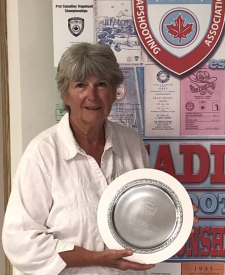
Dianne Wood
Type: Shooter
Category: Lady II
Province: Ontario
Dianne shot her first 100 straight in Singles at the Edmonton Gun Club during the 2004 Canadian Trapshooting Championships and was very proud to have her name added to the club plaque acknowledging shooters that completed the milestone at the club. Dianne was inducted into the Ontario Trapshooting Hall of Fame 2013 and completed her goal of shooting trap in every province in Canada. She did that in 2018 while attending the Atlantic Provinces ATA Provincial Shoot in Yarmouth, Nova Scotia with a quick detour to Prince Edward Island.
Dianne lived in London, Ontario and shot at the Crumlin Sportmen’s Association. She registered her first ATA target in 1980 and attained a lifetime ATA registered target count of 71 800 Singles with a 93.41 average, 63 650 Handicap targets with an 85.08 average and 40 200 Doubles with a 77.87 average. Dianne’s longest handicap yardage assignment was the 25.5 yard line. She got there with a ½ yard punch in 2019 with a 96 at the Missouri Trapshooting Association in Lynn Creek, Missouri.
Dianne and husband Jim (past CTA President and Canadian Champion) attended shoots all over Canada and in the United States. Dianne’s favourite places to shoot were the Canadian Trapshooting Championships no matter the location, Lynn Creek, Missouri and the Atlantic Provinces ATA Provincial Shoot.
Sadly, Dianne passed away on December 23, 2023, just a short time after a cancer diagnosis. True to Dianne’s character, she remained positive and determined to fight until the very end. Dianne’s celebration of life ceremony drew family, friends, and shooters from all over. The Dianne Wood Memorial Shoot held at the Crumlin Sportsmen’s Association threw over 22 000 targets and had 16 squads of Dianne’s friends from far and wide register for the shoot.
Inductees for 2023
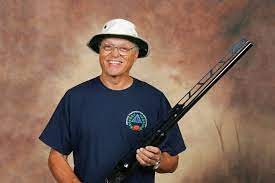
Harry Humby
Type: Contributor
Category:
Province: Manitoba
Harry participated in his first ATA shoot in 2007. During the years that followed, up until the time of his death from pancreatic cancer in 2022, he won more than 160 awards.
Shooting in Manitoba, at his home club, Winnipeg Trap and Skeet Club, and elsewhere around the province, Harry acquired many treasured trophies and, more importantly, many good friends.
In Manitoba Provincial Trapshooting tournaments, Harry’s highlighted wins include the Singles Veteran Championships in 2012 and 2013 and five Singles Senior Veteran Championships between 2015 and 2022. At the Canadian Trapshooting Championship in 2010 he won a Handicap Veteran award and in 2012 received the Handicap Veteran, Singles Class A, and the High All Around Veteran awards.
Harry also participated in American trapshooting tournaments. His most prized awards in Missouri State Shoots were for Singles AA Class in 2012 and Singles Senior Veteran in 2017. At the Southern Grand in Florida, he won a Singles Senior Veteran award in 2014. In Casa Grande, Arizona, Harry’s name was carved on a wooden wall plaque in 2020 because he shot 100 of their unique, green targets, straight.
At the Tucson Spring Grands, Harry’s best achievements were winning five Singles Class A awards and two Singles Senior Veteran awards in the same tournament (2020). In the Singles Championship, Harry was one of only four shooters (out of a total of 587) who shot 200 straight. In recognition of his being awarded the Singles Senior Veteran Champion, his picture appeared, along with those of the other winners, on the front cover of the April 2020 Trap & Field magazine.
Harry competed in 11 Grand American World Trapshooting Championships, winning a total of 22 awards. His most prestigious wins there were the Grand American Handicap Veteran Championship (2011), the high Canadian award (2011), a Champion of Champions Runner-up (2015), and two Singles Senior Veteran awards in 2017.
Between 2010 and 2020, Harry shot 100 straight 37 times and 200 straight four times. He attained the 27 Yard Line in Handicap in 2013. By 2019, he had shot 50,000 ATA registered singles targets, and, by 2022, he had shot 50,000 ATA registered doubles targets. Trap & Field magazine wrote and published an article about Harry in their November 2017 edition.
Harry’s love of trap shooting and the skills that he developed as a high-school teacher and vice principal (28 years), a weekend wedding photographer (20 years), a volunteer swimming instructor (15 years), and a member of the Canadian board for a Christian orphanage/boarding school in Uganda (17 years), helped him make a meaningful contribution to the sport of trapshooting.
From 2014 to 2022, Harry was a working member and the trap chair of the Winnipeg Trap and Skeet Club board. During the last three of those years, he was its president. He also served on the board of the Manitoba Trapshooting Association for four years and then, for two years, as its president.
Harry was a certified ATA/NRA Level I coach. In 2019, he taught a coaching course in Brandon and in Winnipeg. The shooters who completed this course received Level 1 Trapshooting Coach certification which was recognized by both MTA and Sports Manitoba. For Harry, a highlight of every week during the spring season (from 2014 to 2022) was helping to coach sub juniors and juniors at Winnipeg Trap and Skeet Club.
Harry and his wife Francine, his three children and their spouses, and his seven grandchildren, were delighted when his name was added to the Manitoba Trapshooting Hall of Honour in 2022. The Harry Humby Silver Shoot that Winnipeg Trap and Skeet Club held, in Harry’s memory, was wonderful. The Humby family are also truly honoured by Harry’s 2023 induction into the Canadian Trapshooting Association Hall of Fame.

Patrick Lamont
Type: Shooter
Category:
Province: Manitoba
One of just two shooters to have won all five championship events at the Grand American, Pat has collected 11 championship rings at the tournament. In 2008 he topped the Grand American Handicap and All-Around. His 100 from the 27-yard line earned him the handicap crown outright and completed his ATA Grand Slam and Grand American Grand Slam. He repeated the HAA win the following year in 2009 and in 2017. He captured Clay Target titles in 2016 and 2022 and topped the Doubles Championship in 2017. High-Over-All wins came in 2017, 2018 and 2022.
He has claimed numerous Grand American High Canadian trophies since 2002, including 12 in the Clay Target, five in the Grand American Handicap, seven in the Doubles, 15 in the All-Around and 16 in the HOA. He has been past GAH winner seven times. He was Zone Champion of Champions victor in the 2019 Clay Target race. In 2013 he was a member of the winning Zone teams in both singles and doubles. He had another singles team win in 2016 and doubles in 2018.
Pat blasted all 100 during the 2017 President’s Handicap to head the event. He was high gun in the 2011 Champion of Champions and runnerup in 2010 and 2018. He and dad Rob secured the Parent-Child Trophy in 2005, 2011 and 2013 in addition to tying for it in 2003.
His 21 twin-bird centuries at the Grand ties for 10th on the all-time list.
He has won the Spring Grand doubles title once and the all-around and high-over-all crowns twice each.
At the ATA Central Zone Shoot, he has collected 12 titles, including two singles, one handicap, three doubles and six all-around. He set the all-around high of 398x400 in 2013.
Pat has 44 Manitoba provincial titles over the field, including 14 each in singles and doubles plus five handicap and 11 all-around. He swept the championship events in 2009 and 2011. His category singles crowns include the 1998 and 2000 sub-junior and 2001 junior.
At the Canadian Trapshooting Championships, Pat holds 43 Championship titles including 9 Singles (one as a junior and 5 with perfect 200/200 scores), 11 Doubles titles (6 with a perfect 100/100 scores), 3 Handicap, 9 High All Around and 11 High Over All. Pat is one of only 3 Canadians to win all 5 Championship events.
Pat has placed on the ATA All-American Team six times between 2003 and 2023, including one junior and five open. He also has four Trap & Field All-Around Average Awards, and his 2013 singles average of .9972 ties for eighth on the all-time list. Pat has led the association in singles average three times and handicap twice. He has posted a 99%+ singles average (on a minimum of 2,500 targets) 12 times.
In 2002 he reached AA-27-AA status and AAA-27-AAA status in 2015.
Pat is also very active on the organizational side of the sport. He has served as president of Brandon Gun Club for over 10 years and has been Manitoba’s ATA Alternate Delegate for more than 15 years.
Pat credits his dad’s coaching for much of his success in trapshooting. During the CTA Hall of Fame Induction, Pat thanked dad Rob, and his family for their overwhelming support. Pat also considers being inducted into the CTA and ATA Hall of Fame the highest honor he could have in the sport.
Credit: Biographical information sourced and used with permission of the ATA Trapshooting Hall of Fame.
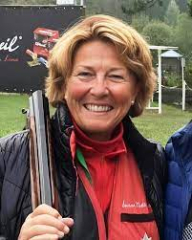
Susan Nattrass
Type: Shooter
Category: Lady II
Province: Alberta
Susan’s shooting career has spanned decades and includes wins at the provincial, national, Amateur Trapshooting Association (ATA), Olympic, and World Cup levels.
Susan has been an instructor, administrator, lecturer and consultant in physical education and sports psychology since 1972 and earned her doctorate from the University of Alberta in 1987. Since 1996 she has been residing in Washington State, conducting research in osteoporosis at the Pacific Medical Center in Seattle.
Provincial Trapshooting Titles
In Alberta Provincial ATA trapshooting competition, she was Lady singles titlist from 1969 to 1974, and from 1980 to 1983. In 1985 she posted a record 199 for the Ladies’ title, and won again in 1988. Two years later she captured the runnerup award.
Susan also has 3 Ontario titles from 1976 through 1978.
While living in Nova Scotia during the 1990s, Susan won five Atlantic Provinces ATA championships. In 1992 she was singles and all-around titlist, and took home the Lady crown in 1991, 1993 (for a record 194), 1994 and 1995. In 1995 she also collected the ATA runnerup award after a tie for the doubles title.
Canadian Trapshooting Titles
At the age 17 Susan won the 1968 Canadian Handicap Champion and in 1979 won the Ladies’ singles, high-over-all trophy, and high-all-around crowns. She has won the Canadian Ladies’ 16-yard championships in 1970, each year from 1974 through 1979 and again in 1980, 1982, and 1987.
She has also won many top Lady category awards in Canada’s national trapshooting championships: 1969 handicap and HOA; 1980 doubles and all-around; 1982 all-around and HOA; 1983 handicap, all-around and HOA; and 1987 doubles and all-around.
ATA Grand American
Susan captured several major trophies in ATA competition during 1969. That year she won the Golden West Grand Handicap Championship with 99 from 21.5 yards and five Ladies’ Grand American awards—including the All-Around crown with 379x400 plus shootoff.
Susan was Grand All-Around titlist again in 1972, 1976 and 1979, and she collected High-Over-All championships in 1972, 1974 and 1976. She won consecutive Doubles crowns in 1972, 1973 and 1974.
Susan won the 1977 Clay Target title, and she recaptured it in 1979. She also earned women’s AA laurels in the Class Singles in 1973, 1976 and 1977. In the Dayton Homecoming she was Lady champion in 1970, 1972, 1973 and 1980.
She was Ladies’ Champion of Champions in 1974 for a perfect century and again in 1975 and 1976. In the 1976 and 1978 International championship events, she collected category honors.
In the 1995 Grand American President’s Handicap, Susan won the Ladies crown with 97 from the 26. Her other handicap awards at Vandalia have come in preliminary events in 1980 and 1982.
Between 1969 and 1987 Susan has collected an additional 23 Grand American awards.
ATA Recognition
Susan was ATA women’s singles average leader in 1970, 1973, 1974, 1976 and 1977, and headed doubles standings in 1974 and 1975. She captured the four top women’s Trap and Field All-Around Average Awards between 1973 and 1976, and second-place ladies’ honors in 1982.
Susan was named to 14 All American women’s teams from 1970 through 1983; co-captained the 1973 team and captained those from 1974 through 1978.
Olympic and World Cup
In 1976, Susan earned the No.1 spot on Canada’s two-member Olympic team to become the first woman in Olympic history to compete in the trapshooting event. In both 1988 and 1992 she filled one of the six women’s positions available, and she was top woman in the open trapshooting event both years.
At World Championships from 1974 through 1981, she won six gold medals and set four world records, including a 195 in 1978 which remains the high mark on 200 targets. Additionally, between 1971 and 1991, she collected three silver and three bronze medals.
At World Cup competitions from 1985 to 1995, Susan has won two women’s Double Trap gold medals plus numerous silver and bronze awards. Additional International shooting honors in her collection include women’s Double Trap silver at the 1995 Pan Am Games and women’s gold at the Grand Prix of Nations, 1984 through 1986.
Recognition
Susan has been inducted into the Canada and Alberta Sports Halls of Fame, the Alberta Provincial Trapshooting Hall of Fame and the ATA Trapshooting Hall of Fame.
Susan has also received many awards and honors, including the Lou Marsh Trophy as Canada’s Athlete of the Year, the Velma Springstead Trophy as Canada’s Female Athlete of the Year, the Shooting Federation of Canada’s Female Athlete of the Year and Field & Stream magazine’s Rookie of the Year.
Credit: Biographical information sourced and used with permission of the ATA Trapshooting Hall of Fame.
See Recent HOF Members